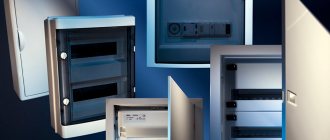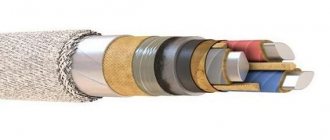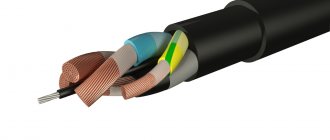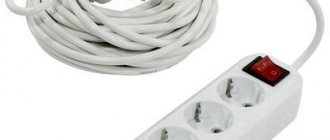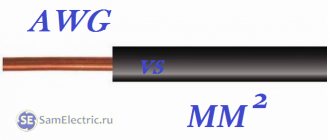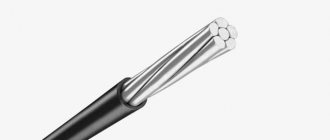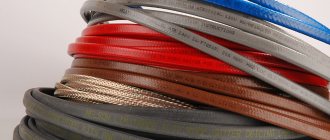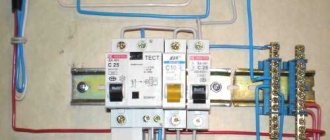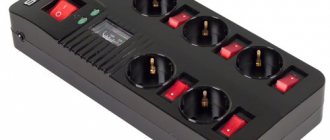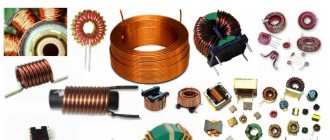Edited by: 28.01.2022
Electricity is a type of energy that ensures not only the operation of almost all industrial enterprises and government institutions, but also a comfortable pastime. To supply electrical energy, different types of cable are used, including power cable.
A power cable is one or more wires in a sealed sheath. Most often, such a cable is used in industrial organizations dealing with a continuous supply of electricity, which is subject to strict safety requirements. If we consider human activity more broadly, then copper or aluminum power cable is used to organize a telephone network and wired Internet. In addition, it is in demand when laying systems in residential buildings, nuclear power plants and underground.
Composition and features of power cables
As noted earlier, a power cable may contain one or more conductive cores having a metallic/non-metallic sheath. On top of this shell there is a protective cover, and in some modifications - armor: it all depends on the operating conditions. In addition to these elements, the cable design requires the presence of protective screens, conductive cores and fillers.
Among TPGs, a distinction is made between main and neutral wires. Moreover, the former ensure the transmission of electricity, and the latter ensure the normal flow of phase current differences arising due to uneven load. They are made of copper and aluminum, and their shape can be round, sector or segment.
Insulation is responsible for giving the TPG the required strength relative to each other and the grounded shell. It can be made of paper, rubber and plastic.
Protective screens are effective means of protecting external circuits from the negative effects of electromagnetic fields of currents. They form a symmetrical electric field around the TPG. Screens can be semiconducting paper, copper or aluminum foil.
Types of products
The purpose of power wires is to transmit electricity to residential buildings, public organizations, and industries. Products are classified according to the parameters and characteristics of cables, internal wires, sheaths, etc.
External (external) protection from precipitation and changes in weather conditions in electrical wiring cables can be armored or unarmored. The control cable differs from the power wire in less strength, because has no reinforcement.
Based on the design of the current-carrying cores, products are divided into single-core cables or cables with 2-5 wires (multi-core).
Classification by voltage strength divides cables into those intended to operate under pressure:
- low;
- average;
- high.
Products differ in total mass and weight of individual elements (insulation, cores, screens).
Popular and in demand power cable designs include the following types:
- PPV;
- APPV;
- VVG;
- PVS;
- VBBShv;
- NUM;
- KG.
The PPV cable consists of a copper core (three-core), protected by a layer of polyvinyl chloride. The products are used for indoor lighting. Products must be attached statically.
APPV wire is made mainly of aluminum alloys; material runs along the length of the wire.
The core of the VVG cable consists of copper and has 1-4 cores. The protective coating consists of PVC. The cables are used to conduct lighting lines in residential and public complexes with different temperatures and air humidity.
Copper in the PVA wire ensures the plasticity of the structure. Depending on the thickness of the product, 2-5 twists of the rod parts are allowed. Wires are used in household appliances, lighting systems, and adapters.
VBBShV cables provide up to 5 twists of cores. The products are used in the construction of power lines. The products are distinguished by their strength and durability.
The NUM wire has an outer sheath of non-flammable material and 2-4 internal cores. The wires are optimal for electrical wiring. The advantage of the products is their resistance to deformation; the design can withstand temperature changes from -50 to +50°C.
Signal cables
Some of them are also called control cables, because they serve to transmit signals from measuring instruments and signals that control the operation of relays, servomotors, etc. The low-current signal cable is divided according to operating frequencies. The highest frequencies are made coaxial; examples of application: television, video surveillance, computer networks. Some of the cables are made in twisted pairs - these are cables for local area networks. There is a special flat “noodle” cable for connecting telephone subscriber devices or radio points inside the building. All such cables, as opposed to power cables, are called low-current.
There are (still) telephone cables made from a large number of pairs of single-wire wires: 20, 50, 100, 200 and more. Special cables for long-distance multi-channel telephone and telegraph communications with compaction were also used. All communication cables were made aerial or armored for laying in the ground. Currently, they are completely replaced by optical fiber.
Control cables operate in harsh industrial environments and must withstand their harsh conditions. For use in home and office environments, they would be rough, to put it mildly.
The concept of a core in electrical wiring
The structure of power cables includes plastic conductors made of metal alloys. The core can be single-wire or multi-wire. The configuration of the element’s cross-section varies (flat, sector). An important characteristic is the cross-sectional area of the core.
Current-carrying and neutral grounding conductors
The conductors, in accordance with their purpose, can be conductive or grounding (zero).
The conductor is the main element in the cable. The core may contain 1-5 wires. The shape of the elements according to the standards is round, segmented or sector-type. Products are standardized by section type and diameter.
Zero cores are used for uneven loads in the electrical network. Grounding threads have a small cross-section and are placed in the center of the wire. The elements ensure safe operation.
Core insulation
The cores in the wires must be insulated with a special coating.
The following are used as protective raw materials:
- paper;
- rubber;
- plastic.
Paper insulation involves applying layers to the conductors and impregnating the raw materials with a fire-resistant compound. The products are used on equipment operating under high voltage.
The insulating rubber coating is plastic, strong, durable. Cores with a rubber sheath are used in cables for connection to devices that are moved during operation. It is necessary to take into account the sensitivity of rubber to sub-zero temperatures. To prevent deformation, the cores are supplemented with a polyvinyl chloride coating.
The insulating layer made of plastic (polyethylene or polyvinyl chloride) is inexpensive, reliable, has high insulation, and a long shelf life.
Single-core and stranded
The power cable design includes wires:
- single-core;
- stranded.
A single-core wire includes 1 current conductor. The products are used in public buildings and residential complexes to supply electricity. In industrial premises, single-core wires are used to output electricity from generators to the general network.
Stranded wires consist of several intertwined wires. To increase ductility, a thread is pulled between the strands. The products are vibration-resistant, flexible, and are designed for connecting household appliances.
ShVVP wire
The main area of application of SHVVP cords is powering a variety of household appliances. Designed for use in networks with voltages of 220 and 380 volts, but can withstand a load of up to 2 kV for a short time. The abbreviation stands for:
- Sh - cord;
- B - type of conductor sheath, in this case PVC;
- B - type of insulation, in this case also PVC;
- P is the wire profile, this cable is flat.
The wire consists of parallel stranded copper conductors, covered with individual insulation, and enclosed in a common sheath that gives the shape of the cord. The number of conductors can be 2 or 3, with a cross-section of 0.5 to 4 square millimeters.
If you have to choose where to buy power cable, choose a reliable supplier. has occupied a leading position in the Russian market since 2007. Reasonable price and European quality are what distinguishes the company’s products from other organizations.
Core material
For the manufacture of cores, different types of raw materials are used (alloys of aluminum, copper, steel). Combined compositions and synthetic core materials are acceptable. To transmit optical signals, the wires are made of plastic or glass. Nichrome cores are used to dissipate thermal energy.
Copper
Copper cores, in accordance with manufacturing technology, are produced either ductile or rigid. The diameter of single-wire elements is 16-95 mm², multi-wire - 25-800 mm². Cores with a rigid structure have a round cross-section. Copper alloys are effective, reliable, durable, but have a high price.
Screens, fillers and shells
The design of a power cable includes the required layers between the insulation:
- screens;
- fillers;
- shells;
- protective coatings.
Screens are designed to protect outer layers from electromagnetic influence. The elements are made of foil and paper treated with a special compound.
Fillers are made in the form of bundles of plastic, rubber, and paper tapes. The elements allow you to adjust the tightness of the junction of parts of the structure. The compositions make the product airtight, resistant to mechanical stress, and give it the required shape.
Sheaths are designed to protect the surfaces of the wire. Parts of the structure are made of alloys of aluminum, lead, non-flammable plastic and rubber. Surfaces can be smooth or corrugated. Sheaths prevent deformation of the wire from the action of water and acid-base compounds.
The final components of the design are protective covers (cushion, armored cover). Armor made of galvanized strips and wires gives the product strength.
Definition
Power cable - in a broad sense, is a cable for transmitting electrical energy, connecting consumers to power from distribution boards of industrial and municipal facilities. It is traditionally accepted that a wire for connecting lighting devices with a cross-section of less than 1.5 sq. mm is lighting, and a cable for connecting more powerful devices is power (this also does not include speaker wire for an amplifier, network wire for a computer, television) .
In some cases, the lighting wire is also called the supply wire. For example, when connecting powerful lighting devices. It is also fair to call twisted pair power cable for retro wiring.
Electrical wiring insulation
The power cable sheath is designed to isolate products from the external elements of the building. The coating must not conduct current.
The main types of cable insulation are represented by coatings:
- from impregnated paper;
- made of durable rubber;
- made of polyvinyl chloride;
- made of polyethylene.
Polystyrene, fluoroplastic, magnesium oxide, etc. can be used as insulation.
The designs of cables covered with paper sheets with a sheath of aluminum and lead are optimal for transmitting electrical energy with a voltage of 35 kV (GOST 18410-73). Aluminum coated insulation materials are not recommended for production sites where caustic solutions are used. Lead-coated insulation protects against aggressive alkaline environments.
Cables with external rubber insulation are suitable for installation of electrical networks with direct voltage up to 10 kV. Wires are used in routes with different levels of electrical wiring (GOST 433-73). The products are highly hygroscopic and plastic. The wire structure is equipped with durable steel armor that prevents deformation.
Cables with polyvinyl chloride insulation are designed for electrical wiring with a rated voltage of 0.66-6 kV (GOST 16442-80). The materials are budget-friendly and flexible. When using additives, the composition becomes resistant to sub-zero or elevated temperatures.
APBbSh, APBbShn, PBbSh, PBbShn:
• in the ground (trenches) with low, medium or high corrosive activity, with or without stray currents, if the cables are not subjected to significant tensile forces during operation;
• in the air if there is a danger of mechanical damage during operation;
• for installation in dry or damp rooms (tunnels), channels, cable mezzanines, shafts, collectors, industrial premises, partially flooded structures in the presence of an environment with weak, medium and high corrosive activity;
Life time
The cable service life is regulated by state standards (GOST 16442-80, GOST 18410-73, etc.), divided into actual and warranty.
The product warranty is issued by the manufacturer for a period calculated from the start of use of the design. The procedure is valid if the buyer complies with the rules of transportation, installation, and operation. The warranty on wires with plastic insulation is at least 5 years. Cables with paper insulation are guaranteed for up to 4.5 years.
The cable shelf life represents the actual period of use of the structure up to the technical parameters permitted by the standard. The actual duration and period of operation for cables with plastic insulation is about 25 years. Wires insulated with impregnated paper can be used for up to 30 years.
